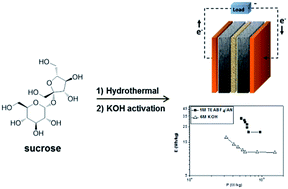Activation of sucrose-derived carbon spheres for high-performance supercapacitor electrodes†
Abstract
Mesoporous carbons were prepared from carbon spheres derived from hydrothermal carbonization of sucrose, followed by KOH activation. The porous structure was tuned by adjusting the ratio of KOH to sucrose-derived carbon spheres. Activated carbons exhibited bi-modal pore size distribution consisting of both micropores and mesopores within 1–5 nm in size, and high surface areas up to 2823 m2 g−1 can be achieved. The activated porous carbons derived from an optimal KOH/carbon weight ratio of 2.5 demonstrated the highest specific capacitance of 316 F g−1 with excellent high-rate performance and good cycling stability. A high power density of 151.8 kW kg−1 with a reasonable energy density of 10.7 W h kg−1 in 6 M KOH aqueous electrolyte could be achieved. Similarly, a high energy density of 32.8 W h kg−1 at a decent power density of 52.5 kW kg−1 in organic electrolyte can be realized, attributed to the high surface area and micro/mesoporous structure. The current study provides a simple, low cost and effective method for the preparation of electrode materials for supercapacitors from biomass.



 Please wait while we load your content...
Please wait while we load your content...